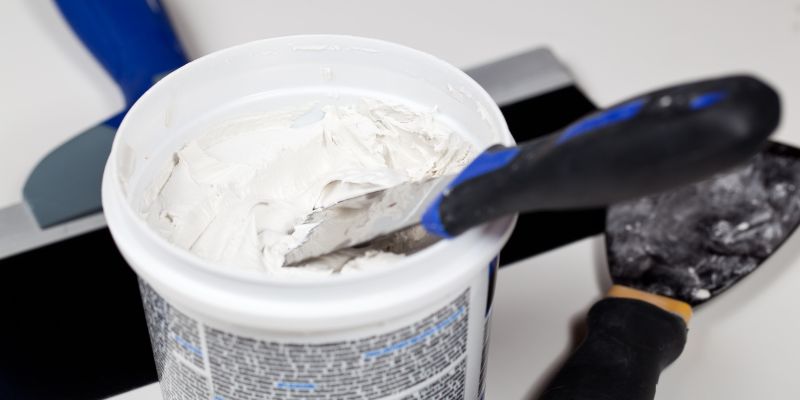Yes, you can use spackle on wood. Spackle is a versatile product that can fill cracks, holes, and imperfections on various surfaces, including wood.
What Is Spackle?
Spackle is a versatile filler commonly used on drywall, but it can also be used on wood surfaces. Its smooth texture and easy application make it suitable for repairing small holes, cracks, or imperfections on wooden surfaces, providing a seamless finish.
Spackle is a versatile repair compound that is commonly used to fill small holes, cracks, and imperfections on walls and ceilings. It is a formulation that is primarily made up of gypsum powder, binders, and water. This popular product is recognized for its ease of use and quick drying time, making it an ideal solution for DIY projects and small repairs around the home. While Spackle is typically used on interior surfaces such as drywall and plaster, it is natural to wonder if it can also be used on wood surfaces.
Composition Of Spackle
The composition of Spackle consists of a few key ingredients that contribute to its effectiveness as a repair compound. Gypsum powder, derived from the mineral calcium sulfate, forms the base of Spackle. It provides the thick and paste-like consistency that allows for easy application and adherence to various surfaces.
Binders are added to the gypsum powder to improve the cohesion and strength of the compound. These binders may include organic substances like cellulose or synthetic materials like vinyl acetate polymers. The binders help Spackle form a tough and durable layer that can withstand minor impacts and moisture.
Water is the final component in the composition of Spackle. It serves as the medium to mix the gypsum powder and binders, creating a smooth paste that can be easily applied to the desired surface. The water content also enables the Spackle to dry quickly, minimizing the overall time required for repairs.
Common Uses Of Spackle
Spackle has been a staple in the world of home repair and renovation for its wide range of uses and applications. While it is primarily used on walls and ceilings, it can also serve as a solution for minor repairs on wood surfaces. Here are some common uses of Spackle:
- Repairing small holes and dents in drywall and plaster
- Smoothing out cracks and imperfections in walls and ceilings
- Filling nail holes and gaps in trim and molding
- Fixing minor damages on wooden furniture and cabinetry
- Sealing joints and seams in various surfaces
These are just a few examples of how Spackle can be utilized in different situations. However, it is important to note that while Spackle can be used on wood surfaces, it may not be the most suitable option for larger repairs or structural damages. In such cases, consulting a professional or using wood-specific repair products would be recommended.

Credit: www.amazon.com
Using Spackle On Wood
If you’re new to home improvement or DIY projects, you may be wondering if it’s possible to use spackle on wood. While spackle is commonly used to fill cracks and holes in drywall, it can be a handy tool for minor repairs on wood surfaces as well. However, there are some factors to consider before using spackle on wood, to ensure the best results.
Can Spackle Be Used On Wood?
Yes, spackle can be used on wood, but it is important to choose the right type of spackle for the job. Regular spackle is typically made for repairing drywall, and it may not adhere properly to wood surfaces. Instead, look for a wood filler or putty that is specifically designed for use on wood. These products are usually made with materials that bond well with wood and provide a durable finish.
Factors To Consider Before Using Spackle On Wood
- Surface Condition: Before applying spackle, make sure the wood surface is clean and free from debris, dust, or loose paint. For the best results, sand the area lightly to smooth out any rough edges or damaged areas.
- Size of the Repair: Spackle is ideal for small repairs and minor imperfections on wood surfaces. For larger or more extensive repairs, it is recommended to use wood filler or putty that is specifically formulated to handle bigger jobs.
- Type of Wood: Different types of wood may require different types of spackle or wood filler. For example, softwoods such as pine may have different characteristics than hardwoods like oak. It is important to choose a product that matches the specific needs of your wood type.
- Drying Time: Keep in mind that spackle typically dries faster than wood filler or putty. If you are working with a large repair area, or if the repair requires a longer drying time, consider using wood filler instead for better results.
By considering these factors, you can ensure that you are using the right spackle for your wood repair needs, resulting in a professional and long-lasting finish. Remember to always read the manufacturer’s instructions and follow the recommended application techniques for the best outcome.
Alternatives To Spackle For Wood
When it comes to alternative options for filling wood, there are a few reliable alternatives to spackle that can provide better results when working with wood surfaces.
Wood Filler Vs. Spackle
If you’re considering using spackle on wood, it’s important to understand the key differences between wood filler and spackle. Wood filler is specifically formulated for use on wood surfaces and is designed to provide strong adhesion and durability. On the other hand, spackle is intended for use on drywall and is not as effective on wood due to its composition, which may not bond well with wood surfaces.
Best Practices For Filling Wood
- Select the right product: Opt for a wood filler specifically designed for use on wood surfaces, ensuring it provides strong adhesion and is sandable and paintable.
- Preparation is key: Before applying any filler, ensure the wood surface is clean, dry, and free of any loose debris or old finishes.
- Apply evenly: When filling wood, it’s essential to apply the filler evenly, ensuring it fills the cracks and holes without overfilling or underfilling.
- Sanding and finishing: Once the filler is dry, sand the wood surface to achieve a smooth finish, and proceed with finishing as desired, whether that involves painting, staining, or sealing the wood.
Ultimately, when working with wood surfaces, opting for a high-quality wood filler will provide the best results and longevity for your project, compared to using spackle on wood.
Precautions And Tips
When it comes to using spackle on wood, it’s important to take certain precautions to protect both the wood’s surface and your safety. Additionally, following a few helpful tips can ensure you achieve the best results possible. In this section, we will discuss the necessary precautions and provide some valuable tips for a successful spackling experience.
Precautions When Using Spackle On Wood
Before applying spackle on wood, it’s essential to take some precautions to avoid potential damage and ensure a satisfactory outcome. Here are some important precautions to keep in mind:
- Ensure the wood surface is clean and dry before applying spackle. Any dust, dirt, or moisture may interfere with the adhesion and drying process. Use a clean, lint-free cloth or brush to remove any debris.
- Wear protective gloves and a dust mask to safeguard your skin and respiratory system from any potential irritants present in the spackle compound. This is particularly crucial if you have sensitivities or allergies.
- When sanding the spackled area, use a fine-grit sandpaper to avoid scratching or damaging the wood surface. Sand gently and in a circular motion until the repaired area blends seamlessly with the surrounding wood.
- Avoid over-applying spackle onto the wood. Excessive amounts can lead to uneven surfaces, prolonged drying times, and difficulty in achieving a smooth finish. Apply thin layers, building up as needed for a seamless repair.
- Allow sufficient time for the spackle to dry before moving on to the next steps. Follow the drying instructions provided by the manufacturer, as different spackle products may have varying drying times.
Tips For Achieving The Best Results
To ensure you achieve the best possible results when using spackle on wood, consider these helpful tips:
- Choose a high-quality spackle product specifically formulated for wood repairs. This will provide better adhesion and a more durable finish.
- Prior to applying spackle, prime the wood surface with a suitable wood primer. This will improve adhesion, seal the wood, and provide a better foundation for the spackle.
- Use a putty knife or a similar tool to carefully apply the spackle onto the damaged area. Ensure you spread the compound evenly across the surface, feathering the edges for a seamless repair.
- If you need to repair deep or large areas, consider applying the spackle in multiple thin layers, allowing each layer to dry completely before adding the next. This will help minimize shrinkage and cracking.
- After the spackle has dried, lightly sand the repaired area to achieve a smooth finish. Start with a fine-grit sandpaper, gradually moving to a finer grit for the best results.
- Finally, protect the repaired wood surface by applying a suitable wood sealant or finishing product. This will help maintain the integrity of the repair and enhance the overall appearance.

Frequently Asked Questions Of Can I Use Spackle On Wood
Can I Use Spackle To Fill In Wood?
Yes, you can use spackle to fill in wood. It works best for small holes and cracks. Sand the area before applying the spackle and ensure it is completely dry before painting or staining the wood.
What Is The Difference Between Wood Putty And Spackle?
Wood putty is used to fill small holes and cracks in wood surfaces, while spackle is a compound used to repair holes in walls. Wood putty matches the wood color, while spackle is typically white.
Can Drydex Spackling Be Used On Wood?
Yes, DRYDex spackling can be used on wood surfaces.
Can I Use Spackling On Plywood?
Yes, you can use spackling on plywood to fill in gaps, holes, and imperfections. It provides a smooth surface for finishing or painting.
Conclusion
Using spackle on wood is possible, but may not yield the best results. Consider using wood filler for a more durable and effective solution. Always test in a small area first, and follow manufacturer instructions for best outcomes. Prioritize the longevity and quality of your woodworking projects.


